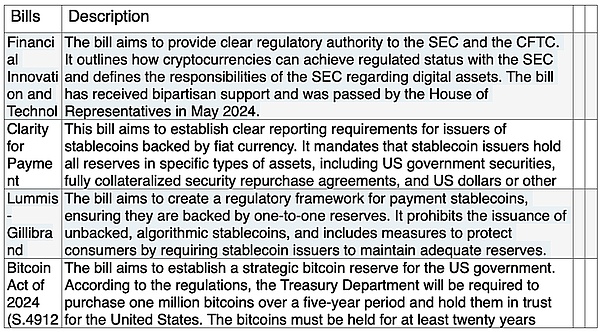Author: Ananya Kumar; Source: Atlantic Council website; Translator: Zhou Ziheng
I am now in Davos, where US President Donald Trump gave an online speech to the attendees on Thursday, emphasizing that the US will become the world's cryptocurrency capital. A few hours later, the White House released the long-awaited digital asset executive order. Since winning the election in November, Trump and his team have been sending all the right smoke signals, including appointing David Sachs as the White House's cryptocurrency and artificial intelligence (AI) czar. Under the Biden administration, the crypto industry's biggest complaint has been unclear regulations and the enforcement oversight of the US Securities and Exchange Commission (SEC). The Trump administration plans to fill the regulatory void early in his presidency and push for a broader deregulation agenda in the innovation space.
As lawmakers show support for the industry - including Congressman French Hill (R-AR), chairman of the House Financial Services Committee (click here to watch his Atlantic Council event on stablecoins), Senator Cynthia Lummis (R-WY), the new chair of the Senate Banking Committee's Digital Assets Subcommittee, SEC Chairman Paul Atkins, and advisors like Elon Musk and Commerce Secretary nominee Howard Lutnick - there is growing confidence that a crypto-forward agenda is imminent. But what does regulatory success look like, and what does it mean for the rest of the world? We dive into the dozen or so bills being considered in Congress and focus on three key themes for crypto regulation by 2025.
SEC and CFTC: Finally a ceasefire?
One of the main divides between the industry and lawmakers is whether the SEC or the Commodity Futures Trading Commission (CFTC) is the appropriate regulator for cryptocurrencies. As Washington often debates, are cryptocurrencies securities or commodities? Under former SEC Chair Gary Gensler, the agency has regularly fined crypto companies for violating securities laws. This has led some lawmakers and the industry to favor the CFTC as the regulator. Several bills under consideration, including the 21st Century Financial Innovation and Technology Act, the Digital Asset Market Structure and Investor Protection Act, the Responsible Financial Innovation Act, and the BRIDGE Digital Assets Act, all address the jurisdictions of the SEC and CFTC over cryptocurrencies.
One of the biggest promises the Trump campaign made to the crypto industry was to end this era of enforcement oversight. Paul Atkins, Trump's pick to replace Gary Gensler as SEC chair, is seen as crypto-friendly. His appointment comes after a series of legal rulings favorable to companies and unfavorable to the SEC over the past two years. After being sworn in, Atkins will have a dual task: he needs to clarify the SEC's jurisdiction over the crypto market and then actually implement the regulation of crypto assets - the issuance, use, and role of crypto assets in the US economy. Congress will ramp up these efforts, and you can expect several bills to rebalance the jurisdictions and enforcement powers of the SEC and CFTC. See below for the full details.
Stablecoins, oh my!
Stablecoins now have over $190 billion in global circulation. They can provide much-needed liquidity to the crypto market and serve as a conduit between crypto and non-crypto assets. Stablecoins are increasingly being used to address humanitarian aid and cross-border payments, such as remittances to Ukraine.
While 98% of stablecoins are pegged to the US dollar, over 80% of stablecoin trading occurs overseas. This makes these "digital dollars" subject to regulatory frameworks developed in Europe, Asia, and Africa. The European stablecoin framework, the Markets in Crypto-Assets (MiCA) regulation, will fully take effect in January 2025. The implementation of this framework should prompt some rethinking on Capitol Hill of the stablecoin legislation under consideration. The Stablecoin Transparency Act and the Lummis-Gillibrand Responsible Financial Innovation Act are two bills under consideration. The Transparency Act has been making its way through the House Financial Services Committee over the past year, coming close to bipartisan consensus several times. It has evolved into a discussion draft proposed by Senator Bill Hagerty. The Lummis-Gillibrand Act was introduced in the Senate in May 2024.
As our Crypto Regulation Tracker shows, crucially, US regulation will play a key role in the future of global crypto. While other countries have been developing their own regulatory frameworks, the US has lagged - a situation that may finally change in the coming months.
Pioneering national Bitcoin reserves
With Lummis appointed as chair of the Senate Banking Committee's Digital Assets Subcommittee, Congress is likely to continue discussing the issue of Bitcoin reserves. The logic behind this bill is to purchase Bitcoin to pay down the national debt. There are still some unresolved questions around Lummis' Bitcoin reserve proposal - including the complex financing model that would revalue gold certificates from 1993 prices to current values.
There are also proposals around a US Central Bank Digital Currency (CBDC). The Trump administration and Republican lawmakers have explicitly stated that a retail CBDC or digital dollar will not happen in the US. This puts the US at odds with counterparts in Europe, which will launch a digital euro pilot in 2025, and the UK, which just established a CBDC lab last week. The executive order directs all agencies to halt any ongoing CBDC work.
Here are the details of all the major legislation currently under consideration.










